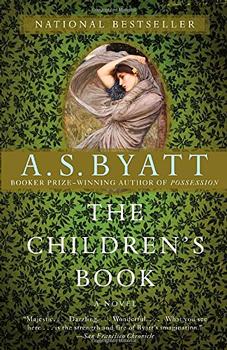Summary | Excerpt | Reading Guide | Reviews | Beyond the Book | Readalikes | Genres & Themes | Author Bio

A Novel
by A.S. Byatt
"Candlestick?"
"The Gloucester Candlestick. What he seems to be drawing, a lot of the time. The lump of gold, in the centre of that case. It's ancient and unique. I'll show it to you. We could go down, and go up to it, and disturb him." Tom was dubious about this. There was something tense about the third boy, a tough prepared energy he didn't even realise he'd noticed.
However, he agreed. He usually agreed to things. They moved, sleuthlike, from ambush to ambush behind the swags of velvet. They went under Prince Albert, out onto the turning stone stairs, down to the South Court. When they reached the Candlestick, the dirty boy was not there.
"He wasn't on the stairs," said Julian, obsessed.
Tom stopped to stare at the Candlestick. It was dully gold. It seemed heavy. It stood on three feet, each of which was a long-eared dragon, grasping a bone with grim claws, gnawing with sharp teeth. The rim of the spiked cup that held the candle was also supported by open-jawed dragons with wings and snaking tails. The whole of its thick stem was wrought of fantastic foliage, amongst which men and monsters, centaurs and monkeys, writhed, grinned, grimaced, grasped and stabbed at each other. A helmeted, gnomelike being, with huge eyes, grappled the sinuous tail of a reptile. There were other human or kobold figures, one in particular with long draggling hair and a mournful gaze. Tom thought immediately that his mother would need to see it. He tried, and failed, to memorise the shapes. Julian explained. It had an interesting history, he said. No one knew exactly what it was made of. It was some kind of gilt alloy. It was probable that it had been made in Canterbury - modelled in wax and cast—but apart from the symbols of the evangelists on the knop, it appeared not to be made for a religious use. It had turned up in the cathedral in Le Mans, from where it had disappeared during the French Revolution. A French antiquary had sold it to the Russian Prince Soltikoff. The South Kensington Museum had acquired it from his collection in 1861. There was nothing, anywhere, like it.
Tom did not know what a knop was, and did not know what the symbols of the evangelists were. But he saw that the thing was a whole world of secret stories. He said his mother would like to see it. It might be just what she was looking for. He would have liked to touch the heads of the dragons.
Julian was looking restlessly around him. There was a concealed door, behind a plaster cast of a guarding knight, on a marble plinth. It was slightly ajar, which he had never seen before. He had tried its handle, and it was always, as it should be, since it led down to the basement storerooms and workrooms, locked.
"I bet he went down there."
"What's down there?"
"Miles and miles of passages and cupboards and cellars, and things being moulded, or cleaned, or just kept. Let's stalk him."
There was no light, beyond what was cast on the upper steps from the door they had opened. Tom did not like the dark. He did not like transgression. He said "We can't see where we're going."
"We'll leave the door open a crack."
"Someone may come and lock it. We may get into trouble."
"We won't. I live here."
They crept down the uneven stone steps, holding a thin iron rail. At the foot of the staircase they found themselves cut off by a metal grille, beyond which stretched a long corridor, now vaguely visible as though there was a light-source at the other end. The passage was roofed with Gothic vaulting, like a church crypt, but finished in white glazed industrial bricks. Julian gave the grille an irritated shake and it swung open. He observed that this, too, should have been locked. Someone was in for trouble.
The passage opened into a dusty vault, crammed with a crowd of white effigies, men, women and children, staring out with sightless eyes. Tom thought they might be prisoners in the underworld, or even the damned. They were closely packed; the boys had to worm their way between them. Beyond this funereal chamber, two corridors branched. There was more light to the left, so they went that way, negotiated another unlocked grille, and found themselves in a treasure-house of vast gold and silver vessels, croziers, eagle-winged lecterns, fountains, soaring angels and grinning cherubs. "Electrotypes," whispered the knowledgeable Julian. A faint but steady light rippled over the metal, through little glass roundels let into the brickwork. Julian put his finger to his lips and hissed to Tom to keep still. Tom steadied himself against a silver galleon, which clanged. He sneezed.
Excerpted from The Children's Book by A.S. Byatt Copyright © 2009 by A.S. Byatt. Excerpted by permission of Knopf, a division of Random House, Inc. All rights reserved. No part of this excerpt may be reproduced or reprinted without permission in writing from the publisher.
Your guide toexceptional books
BookBrowse seeks out and recommends the best in contemporary fiction and nonfiction—books that not only engage and entertain but also deepen our understanding of ourselves and the world around us.